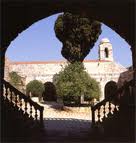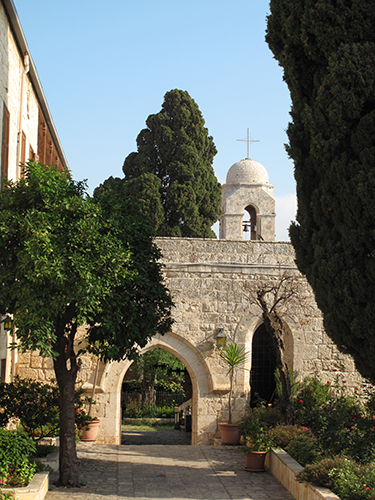Our Lady of Balamand Patriarchal Monastery
 Balamand derives from the French Belmont
Balamand derives from the French Belmont
the name given by twelfth-century Cistercian monks to their first monastery in the Levant, founded on a hill three hundred meters above sea-level, overlooking the coastal plain sixteen kilometers southeast of Tripoli and eighty kilometers north of Beirut. Since 1603, the site has been the center of an Antiochian Greek Orthodox monastery dedicated to the Virgin Mary and to St George. It remains a place of prayer and contemplation, but since the 1970s, Balamand has become a complex of religious and educational institutions. These include the secondary school of Our Lady of Balamand, the St John of Damascus Institute of Theology, and the University of Balamand, founded in 1988, of which the Institute has become a part.
| Our Lady of Balamand Patriarchal Monastery | |
| Abbot: | Rev. Archimandrite George Yacoub |
| Postal Address: |
Our Lady of Balamand Patriarchal Monastery. P.O. Box 100 Tripoli, Lebanon |
| Tel: | +961 6 930 311 |
| E-mail: | |
| WebSite: | www.balamandmonastery.org.lb |
History
The nature of the site suggests that an early Byzantine monastery may have existed at the site. It is certain, however, that Cistercian monks from France founded the monastery of Our Lady of Belmont in 1157, as the first and most important of several Cistercian establishments in the Levant.
The buildings of the monastery, completed between 1157 and 1169, reveal a high level of prosperity, which lasted until the later thirteenth century. Although no document survives to record the life of the Cistercian abbey, its importance can be guessed at from the extent of arable land that belonged to it. The Cistercians were renowned for their strenuous agricultural activity, easily apparent from the numerous cellars, depots, and barns at Belmont monastery.
The destruction of the Crusader States by the rising Mamluk power cut short the prosperity of Belmont. The monastery is mentioned in Cistercian records for the last time in 1287. The Mamluks finally took Tripoli in 1289, massacring and enslaving the population.
The three centuries between the end of Belmont and the re-establishment of the monastery by Orthodox monks are poorly attested.  Archaeological surveys conducted since 1964 have uncovered no ceramics or other remains from the Mamluk period, suggesting that the monastery was completely abandoned. On the other hand, an Orthodox manuscript written in Syriac and Arabic, dated 1492, indicates that there was an occupation of the site around that time by hermits, although it was probably short-lived.
Archaeological surveys conducted since 1964 have uncovered no ceramics or other remains from the Mamluk period, suggesting that the monastery was completely abandoned. On the other hand, an Orthodox manuscript written in Syriac and Arabic, dated 1492, indicates that there was an occupation of the site around that time by hermits, although it was probably short-lived.
The name Balamand is first recorded in the Ottoman census of Syria drawn up in 1521, five years after the Ottoman conquest. It is listed as a farm belonging to the estate of an Ottoman official. As such, it is mentioned again in the second Ottoman census of 1571 as belonging to the estate of the citadel of Tripoli. These official entries make no mention of the monastery itself, but manuscripts copied at Balamand in 1598-1599 show that there was a limited, probably unofficial monastic occupation at the end of the century.
The official restoration of Balamand monastery took place in 1603. The first page of the monastic register, written in 1610, records that the Cistercian abbey had been restored by Greek Orthodox monks after lying abandoned for 330 years, following agreement between the Orthodox hierarchy and the notables, monks, and people of the district of al-Kura. The action was taken by Youwakim, metropolitan of Tripoli (1593-1604), with the indispensable support of local Muslim officials, and Sulayman al-Yaziji, the Christian secretary to the Ottoman governor of Tripoli. The monastery was derelict and possessed no land; however, the surrounding agricultural estate was officially transformed into monastic waqf (land held in mortmain). The first abbot was Makarios al-Dirani, previously abbot of Kaftoun, and about a dozen monks initially moved from Amyoun to Balamand. Vineyards, mulberry orchards, and olive groves were planted; a flock of goats and a herd of cows were acquired. By 1610, when the register was written, monastic life was firmly established and it continued to flourish uninterruptedly. Balamand was fortunate to pass unharmed through the conflicts that ranged Lebanese clans, factions, and confessions against one another throughout the Ottoman period. Indeed, the monastery became an important local center, renowned for its hospitality to refugees and visitors of all kinds. The English traveler, Henry Maundrell, stayed at Balamand in 1697 and left a valuable description:
The Monks of this Convent were as I remember forty in all. We found them seemingly a very good natur’d, and industrious, but certainly a very ignorant People. For I found upon enquiry that they oculd give any manner of Rationale of their own divine Service. And to shew their extreme simplicity, I cannot omit a compliment, made to the Consul by the chief of them, viz. that he was as glad to see him, as if he had beheld the Messiah himself coming in person to make a visit to him.
Nor is this ignorance to be much wondered at; for what Interval of time, they have between their hours of Devotion, they are forced to spend, not in Study, but in managing of their Flocks, cultivating their Land, pruneing their Vineyards, and other labours of Husbandry, which they accomplish with their own hands. This toil they are obliged to undergo, not only to provide for their own sustenance, but also that they may be able to satisfy the unreasonable exactions, which the greedy Turks, upon every pretence they can invent, are ready to impose upon them. But that it may be the better guess’d what sort of men these Greek Monks are, I will add this further indication, viz. that the same Person, whom we saw officiating in the Altar, in his embroyder’d sacerdotal Robe, brought us the next day, on his own back, a Kid, and a Goat’s Skin of Wine, as a present from the Convent.2
From an early date, the monastery of Balamand entertained good relations with the Russian state and Church. In 1651, the monks of Balamand wrote to tsar Alexis, requesting the dispatch of alms. The monk Saba was placed in charge of collecting contributions from Russia. The tsar and Patriarch Nikon ordered all border officials to facilitate the passage of the archimandrite Saba, supplying horses and guards and forbidding any levy of taxes upon him.
An important recorded event in the history of Balamand during these long centuries was the schism within the Antiochian Greek Orthodox Church during the early eighteenth century. Balamand was a key objective of the Catholic effort to promote a Uniate movement within the Antiochian Church. According to Antoine Nacchi, the Jesuit Superior-General for Syria and Egypt at that time, Balamand ‘has always had the reputation of being the richest and largest of all the monasteries that the Greeks possess in Syria’.3 Nevertheless, the region of al-Kura remained attached to Orthodoxy, and the Uniate crisis was felt less acutely at Balamand than it was in most Orthodox parishes and monasteries farther south.
Following the departure of the Uniates in the early 1720s, the number of monks fell to thirty. They were heavily taxed by the Ottoman state. According to Russian sources, after the beginning of the Greek revolt in 1821, the Monastery of Balamand suffered reprisals and was abandoned for a time. In 1830, there was a revival with the coming of the superior Athanasios.
Architecture
With its buildings spread out over an area of almost 5,000m², Balamand monastery resembles a small village. Two ancient doors in the south and east walls lead into a square interior court, flanked on the north and west by the churches of Our Lady and St George, and on the south and east by great halls and vaulted cellars. Two stone staircases lead to an upper floor. The plan is typically monastic – fully enclosed, with the church placed farthest from the main entrance. However, its high position overlooking Tripoli and the coast is quite untypical of Cistercian monasteries, which were usually founded in fertile valleys: Balamand’s strategic location was probably chosen with an eye to security and surveillance of the coastal road.
Most of the ground floor level belongs to the medieval Cistercian abbey. Except for certain modifications made for better security, it is typical of Cistercian foundations everywhere. Laid out on a square plan around a cloister, its buildings are of carefully dressed white limestone, pleasingly proportioned, and extremely austere. Cistercian architecture was dominated by the same strict order that ruled the lives of Cistercian monks. The abbey must represent the perfect square of the heavenly Jerusalem. The square is the ideal shape, symbolizing the number four, number of the cardinal virtues, the elements of nature, the rivers of Eden, and the Gospels. It also recalls the fourfold definition of God given by the founder of the Cistercian order, St Bernard of Clairvaux: ‘He is length, width, height, and depth’.4
The Church of Our Lady of Belmont, lying at the north end of the cloister, is the central focus of the abbey. It consists of a single nave ending in a great apse blocked in by two rectangular chambers on either side. The church’s barrel vault rests entirely on the massive exterior walls, nearly two metres thick and completely bare, except for a plain cornice running throughout at the base of the vault and a large rose-window above the west entry. The church’s great size indicates that the Cistercian abbey must have housed a large community.
The bell-toweris the most striking exterior feature of the monastery. Of Provençal Gothic style, it is the only surviving medieval stone bell-tower in the Near East. Rising above the triumphal arch of the apse, it is square-shaped, each face decorated by a handsome arched bay. The tower has two vaults, of which the upper is surmounted by a dome.
The monks walked around the central cloister, reading the Divine Word and contemplating the sacred space that symbolized elemental Creation and Paradise restored. With its square pylons and roughly built vaults, the existing cloister is clearly of modern date: little survives of the Cistercian cloister except for incorporated decorative fragments.
To the north-east of the cloister is the thirteenth-century Great Hall, a massive and powerful building, even larger than the church. The Cistercians would normally have used it as a hospice for travellers and, in emergency, as a shelter for refugees. The original vault was replaced in the seventeenth century by a new vault of similar style but placed at a lower level, so that the elegant rose-window in the west entrance is now too close to the vault.
Between the Great Hall and the Church lies the Capitulary Hall. Here the monks would assemble every day around their abbot to hear his moral and practical instructions and to read the martyrology or the rules of the Cistercian order. The hall contains an apse, possibly part of the original construction, but more likely added in the seventeenth century, when the building was converted into St George’s chapel. Cistercian abbots were buried in the capitulary hall, and surveys have found the previously undisturbed tombs of four abbots.
To the south of the cloister lies the well-preserved Cistercian kitchen, a rectangular barrel-vaulted room equipped with chimney and ovens. It communicates with the refectory, where the monks assembled twice daily for meals that normally consisted of bread and vegetables only – meat and oil were excluded. Only the refectory windows are original; the rest of the building is of nineteenth-century date, and it now serves as an entrance-hall for the monastery.
Other Cistercian buildingsinclude three rooms communicating with the kitchen and two near the church, which all served as storerooms and stables. A similar large room, isolated to the south of the kitchen, probably served as the hospital and pilgrims’ hall. All these rooms are soundly constructed, with barrel vaults and narrow embrasures in the walls.
The Orthodox period brought important additions to the layout and furnishing of Balamand monastery. The Orthodox monks re-used Cistercian building stones, pillars, and decorative elements; they converted the capitulary hall into the chapel of St George; and they embellished the church of Our Lady with a new altar, a carved wooden iconostasis, valuable icons, gilded and painted crucifixes, faïence panels, and white marble paving-stones.
Moreover, the monks added three new sections to the monastery – the Aleppine wing, the patriarchal wing, and the school. These additions were all built on first-floor level above existing constructions. In general, they harmonize pleasingly with the medieval buildings, using the same white stones and adopting a similar style for doors, windows, and vaults.
The Aleppine wing was begun in 1652. Lying between the apse of the church and the capitulary hall, it consists of a large hall communicating with eight vaulted cells now used to house visitors. Following the Cistercian manner, there is no decoration, and the observer from the cloister notices how well the Aleppine wing appears beside the medieval capitulary hall.
Begun in 1711, the patriarchal wing covers the whole of the great hall and most of the capitulary hall. It has always functioned as permanent residence for the Bishop of Tripoli and Kura, and as a guest-house for the visiting Patriarch of Antioch. The section above the capitulary hall is subdivided into a narrow corridor with two domed cells on either side; an open loggia containing a small arcade of transposed material from the old abbey; and, finally, the bishop’s dining-room. The section above the Great Hall consists of a long open passage, opening on the right into four small cells followed by a suite of spacious living-apartments on two floors. This part was constructed in 1832 by the superior Athanasios to be the first Arabic school for Orthodox priests in the Patriarchate of Antioch.
Built in 1899-1903, the school is the latest addition to the monastic complex. Intended to receive up to forty boarding students, teachers, and employees, it was designed on a large scale and covers all the medieval buildings – kitchen, refectory, pilgrims’ hall, and stables – that lie to the south of the cloister. It consisted of a dormitory, refectory, kitchen, study hall, class-rooms, living quarters and store-rooms, all of which are presently used for lodging first-year students at the Institute of Theology. The school’s red-tiled roofs contrast strikingly with the monastery’s expanse of white stone.
Manuscripts
The 170 manuscripts held at Balamand’s Institute of Theology are a valuable heritage of the Antiochian Greek Orthodox Patriarchate.The collection began with the Orthodox restoration of the monastery in 1603 and grew steadily thereafter despite the donation of many manuscripts as gifts, some of which were eventually deposited in Western libraries. A number of manuscripts were stolen during the Lebanese civil war but were restored in 1987, with the regrettable exception of three precious illuminated Gospels. Two of these are the work of the famous artist Yousuf al-Musawwir, who lived in Aleppo at the end of the seventeenth century.
Most of the collection was written in Arabic during the seventeenth, eighteenth, and nineteenth centuries. Some medieval manuscripts also contain writings in Syriac, then still widespread within the Antiochian Greek Orthodox community. Greek manuscripts are few. The collection is valuable mainly for its illustration of Antiochian Orthodox life and thought from the sixteenth to the nineteenth centuries. The collection includes 97 liturgical manuals, 44 patristic and theological manuscripts, and 22 synaxaries (lives and miracles of the saints), which were read during liturgical festivals to provide edifying examples of faith and holiness. There are four Church histories and three polemical manuscripts. Biblical texts include a kachkoul (collection of summaries of each book in the Bible) and five precious seventeenth-century illuminated Gospels, of which three were stolen and are still missing. The most ancient manuscript in the collection is a thirteenth-century copy of the Romance of Barlaam and Iosaph, which carries nine illuminations showing the lives of these two saints. Their style reflects the interaction of Byzantine and Syrian iconography with Islamic art. Finally, there is an illuminated manuscript of Orthodox canon law, written in Arabic at the end of the nineteenth century and illustrated with Arabic calligraphy and icons.
The copying, translation, revision, and correction of manuscripts was encouraged by the moral and often financial support of the monastic superiors at Balamand, named as ‘benefactors’ in the colophons that were usually appended to the end of manuscripts. The colophon’s official purpose was to record the history of the manuscript to which it was attached – information that reveals how closely Orthodox monasteries of the region cooperated in order to preserve their heritage. In addition, these colophons reveal much about the history of Balamand itself during the Orthodox period – its architectural development, its hospitality to visitors, and its role as a shelter for refugees during times of war, epidemic, and earthquake.
Icons and precious objects
During its 400-year existence as a center of Greek Orthodox faith in the Near East, Balamand monastery has acquired a rich patrimony of religious art. Each of its two churches was decorated with a sumptuous iconostasis. The one in Our Lady’s Church is of polished dark walnut, carved in Macedonia in the late seventeenth-century: the church of St George possesses a beautiful black-and-white marble iconostasis of Syrian origin. Upon the iconostases and walls of the two churches is an array of icons, originating especially from Aleppo in the late seventeenth and early eighteenth centuries and Jerusalem in the later nineteenth century. They constitute a fascinating display of iconographic history. The most glorious example of this rich heritage is the unique and reputedly miraculous icon of the Virgin Hodegetria, dated 1318 but thought by many to be of tenth-century origin; possibly the oldest icon in the Near East, it is now preserved to the left of the iconostasis in the Our Lady’s Church. It was restored by Michael the Cretan at the beginning of the nineteenth century.
Icons were essential in Orthodox monastic life primarily as a support for meditation, even as a kind of window into the other world, a means of perceiving the transcendent reality. According to St John of Damascus, ‘The icon of Christ is Christ Himself, and the icon of the saint is the saint himself; the face and the glory are not divided, but the glory becomes the attribute of that which is represented’. All saints and divine persons are therefore represented with a halo, the symbol of uncreated light. The haloes of Christ are marked with a cross. Sanctity and divinity are also expressed in the serenity, formal poses, and distant regards of the figures.
In addition, the icons served a didactic purpose, by illustrating scenes from the life of Christ and the saints: ‘Sight leads to belief better than does hearing; what is placed before the eyes expresses itself more deeply in the soul and, by sense-perception, takes root in the feelings’.5 For example, the icon of the two SS Simeon Stylites at Balamand contains ten small pictures at the base representing miracles accomplished by these saints. An icon of the Last Judgement shows in different colours the four kingdoms of the universe: blue Heaven, white Paradise, red Earth, and black Hell. The scenes from Hell are full of picturesque details directly inspired by the homilies of St Ephraim, copies of which exist at Balamand. Each scene is accompanied by an explanatory formula taken from the Bible. In the same manner, the icon of the Dormition, on the wall of Our Lady’s Church, perfectly expresses Orthodox dogma on the Theotokos, the Virgin Mother of God. These two great icons were stolen during the Lebanese civil war, and they have not yet been returned.
Finally, the icons played a central role in the Orthodox liturgy. During the celebration, the priest leaves the central door of the iconostasis several times to address the icons with invocations and prayers, and to incense and bless them. The icons are also carried in procession, particularly on the first Sunday of Lent, known as Orthodox Sunday or Icon Sunday. At Balamand, as elsewhere, the iconostasis must display the Virgin Theotokos to the right of the central, royal door and Christ to the left. To the right of the Virgin is placed an icon of the saint to whom the church is dedicated. In the case of Our Lady’s Church at Balamand, this place is taken by the icon of the Dormition.
Icon inscriptions indicate the names of painters, monastic superiors, and donators. Individuals and families donated the icons to the monastery as waqf-property, usually for the repose of souls and to assist the salvation of the donators. Most of the Aleppine icons of the late seventeenth and early eighteenth centuries are signed by Ne‘meh al-Musawwir, whose work was closely supervised by the priest Farah, superior of Balamand at that time. The nineteenth-century Palestinian icons were painted by Master Ishaq Nicolas al-Urushalimi during the time of the superior Parthenios. Other icons came from Russia at the end of the nineteenth and start of the twentieth centuries, a period of intense religious and cultural exchange between the Patriarchates of Antioch and Moscow.
The painters faithfully preserve the stereotyped traditions of Byzantine icon-painting, which govern the composition of each theme and the characteristic elements of each mystery and figure. However, the urban society of the Ottoman Near East strongly influenced the painters of Aleppo and Jerusalem in three particular aspects. First, the facial features, clothing, and accessories of the saints and divine persons are typically Oriental. Secondly, the decoration is sumptuous, filled with detail and ornament. The painters leave no empty spaces, and their decoration follows the precise rules of Islamic art with its typical motifs – flowers, plants, and geometric patterns. Finally, the Arabic inscriptions of the icons are frequently long and narrative in form. Throughout the Christian East, Melkite icons include the fullest and most detailed texts, in keeping with the didactic role of the icon. Apart from long dedications, there are also episodes from the lives of saints and Biblical quotations.
The artistic heritage of Balamand includes a collection of precious and beautiful liturgical objects, including printed Greek Gospels bound with covers of engraved silver; eighteenth-century chalices of silver filigree and inlaid jewels; silver or gold processional crosses; and six smaller crosses of wood with gold or silver inlay, which were probably crafted in Mount Athos in the eighteenth century. Most beautiful of all are the liturgical vestments, woven of satin or velvet and embroidered with silver, golden, and silken thread. Embroidered arabesques, scenes, and persons are exquisitely represented in small spaces.
In the last four decades, the Antiochian Orthodox institution at Balamand has expanded vastly. Its development from monastery to school, theological institute, and university is firmly rooted in its particular Eastern heritage, yet rises above it towards a universal perspective. The University’s constitution expresses this upward striving in its insistence that freedom is connected with joy and humility – joy springing from faith, and humility from the infinity of knowledge and a deeper understanding of man.
Source: Monasteries of Antiochian Orthodox Patriarchate, University of Balamand Publications, 2007.
2 Maundrell, Henry. A Journey from Aleppo to Jerusalem, p. 28-9.
3 Choix des letters édifiantes écrites des missions étrangeres précédé de tableaux des pays de mission, 23.
4 Duby, Georges. St Bernard et l’art cistercien, 136.
5 St Nicephorus at the Seventh Ecumenical Council of 787, quoted in Agémian, S. Icones melkites, 32.

2025-12-25
2025-12-24
2025-12-23
Patriarch John X Receives the…
2025-12-22
Inspection Visit to the…
2025-12-21







